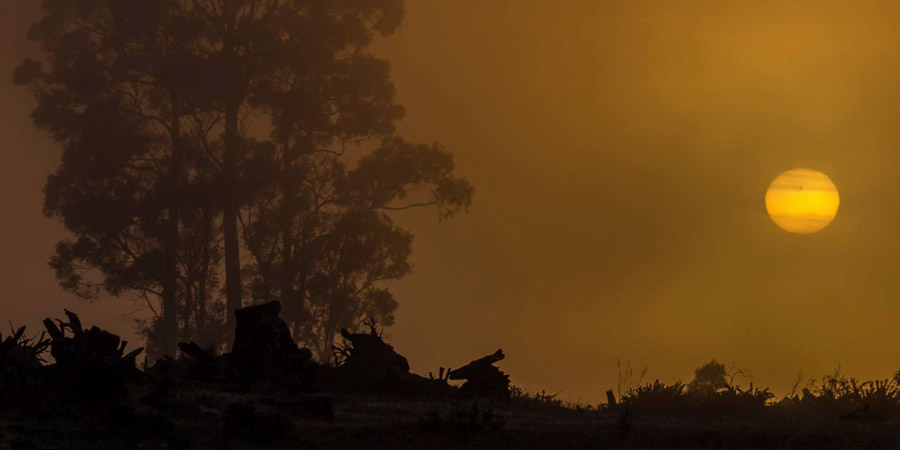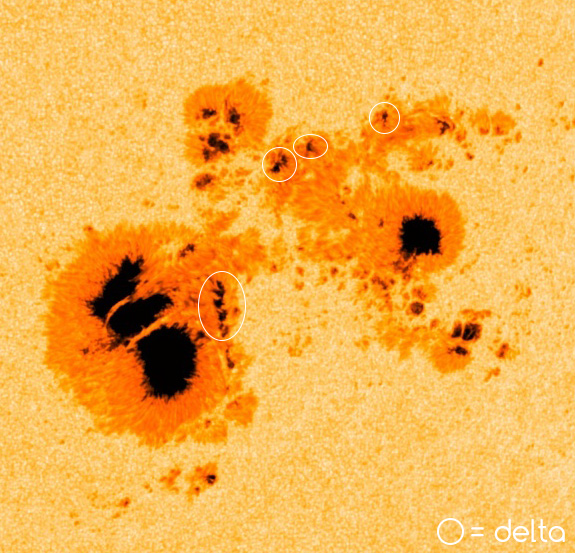Evolution of sunspot region 2192
Saturday, 25 October 2014 16:26 UTC

Solar activity has been low since yesterday's X3.19 solar flare which did not release a coronal mass ejection. The strongest solar flares today have been two C9 class solar flares. Sunspot region 2192 decayed slightly but it's largest delta spot near the large trailer spot continued to strengthen. We will take a look at it in this article. Sunspot region 2192 remains however one of the largest sunspot regions in modern times and it is so large that it can be seen by the naked eye. Our header image comes from Simon Toogood who captured this image of the Sun that shows large sunspot region 2192 in all it's glory. The setting Sun was dimmed so much by dense haze over Australia that he could capture this cracking shot. Do note that you should never look at the sun without proper eye-protection or through unfiltered optics. Even when dimmed, the Sun can still cause serious eye damage when directly viewed trough a lens.
Evolution of sunspot region 2192
Sunspot region 2192 showed some signs of decay, losing some penumbral area but there is a delta spot near the large trailer spot that continues to grow and strengthen. There was also some development near the northern leader spot where we can find three small delta spots right now. Overall, while it did loose some penumbral area coverage it is a positive sign that it's largest delta spot continues to grow. Sunspot region 2912 remains magnetically complex and it is likely that we see more M-class solar flares in the next 24 hours. An X-class (R3) event can also not be ruled out.

All the other sunspot regions on the disk are unremarkable. Any future solar flares will very likely be centered around sunspot region 2192 which is now facing Earth, but it is slowly on it's way towards the western limb. A strong eruption from sunspot region 2192 could cause a solar radiation storm.
Solar flare odds for the coming 24 hours
M-class flare probability: 65% chance
X-class flare probability: 15% chance
Images: NASA SDO and Simon Toogood.
Thank you for reading this article! Did you have any trouble with the technical terms used in this article? Our help section is the place to be where you can find in-depth articles, a FAQ and a list with common abbreviations. Still puzzled? Just post on our forum where we will help you the best we can!
Latest news
Latest forum messages
Support SpaceWeatherLive.com!
A lot of people come to SpaceWeatherLive to follow the Sun's activity or if there is aurora to be seen, but with more traffic comes higher server costs. Consider a donation if you enjoy SpaceWeatherLive so we can keep the website online!

Space weather facts
| Last X-flare | 2025/03/28 | X1.1 |
| Last M-flare | 2025/04/18 | M4.4 |
| Last geomagnetic storm | 2025/04/16 | Kp8- (G4) |
| Spotless days | |
|---|---|
| Last spotless day | 2022/06/08 |
| Monthly mean Sunspot Number | |
|---|---|
| March 2025 | 134.2 -20.4 |
| April 2025 | 120.1 -14.1 |
| Last 30 days | 116.4 -25.9 |


